by Dot Cannon
“The IoT lifestyles kind of crept into our lives,” said Will Tu.
SENSORS Expo 2017 was starting off, Tuesday morning, with five pre-conference symposia in San Jose’s McEnery Convention Center.

And Will, who is DSP Concepts‘ Vice-President of Business Development, had coordinated that day’s symposium on the Internet of Things, entitled, “IoT Lifestyle: Invisible Technology Moving in Your Home, Your Car, Your Office”.

“Back in 1991, Mark Weiser wrote, ‘the most profound technologies are those that disappear. They weave themselves into the fabric of everyday life until they are indistinguishable from it,'” Will said in his introductory remarks.
“To me, that’s what IoT is all about.”
Will said the day’s sessions would include a look at the high-level image of the Internet of Things, as well as perspectives of what was going on in the market. Scheduled speakers would also cover use cases, trends and an exploration of the software aspect of IoT.
There would also be a new symposium feature: a panel discussion with analysts, rather than component providers. Will said he made that choice because the component people tended to be “too nice” to each other in a discussion-panel format.

“I’ve kind of encouraged all the speakers to be a little bit opinionated.”
A road map–and a ways to go
The day’s first session speaker, ARM Vice-President of New Business Development Charlene Marini, offered listeners a look at the ways connected devices had changed over time.
“When I think about invisible technologies, the first thing I start off with is visible technologies,” she said.
The first visible intelligent device, she continued, was the Apollo guidance computer. But it was not small.

“It weighed about seventy pounds–I couldn’t carry it,” she commented, before showing her audience the point to which current technology had evolved. 
“It’s not just a computer,” she said. “It’s a sensor, solar panel, radio and battery. This is the future…tiny, tiny little computers.”
And those tiny computers would show up in all kinds of areas, including swallowable pills, and an increased capability for oil rigs to gather information, Charlene said.
“Oil rigs can be quite intelligent today. Some of them have up to thirty thousand sensors–but only 1 percent of that is used.”
Presently, she said, increasing that capability would be a complex process. Further deployment of the IoT is currently hobbled by issues including cost, privacy concerns and lack of standardization.
“The device has to be able, not just to take inputs, but also to provide feedback,” she explained. “But we’re a long way from getting to this point…There needs to be a facility to connect with any type of device, any type of application.
“At ARM, we believe none of this can happen unless we start with security.”
“There’s no such thing as absolute security. That’s why life cycle security is so important…We need to enable security, even on the cheapest devices, for people (who have) no security experience.”

Once that security was in place, she said, simplification could follow. Devices would then be able to interact, with developers deploying different types of software.
“AI is going to be dependent on application developers,” she continued. “Today, application developers don’t know what a device is,…and they’re never going to care what a device is.
“It’s going to be about what is important to humans in our daily lives.”
Change and a need for openness
“One of the things I really think is cool, is history,” said Tridium Sales Director Curt Bramel at the start of his session. “I always say IoT is going to have to change to IoE: Internet of Everything.”
“When you look at the connected world, that’s not new,” he continued. But now, how do you take machines and tie them to other machines?…As long as you think, ‘open framework'”, you always have a community of developers out there.”
Curt warned that, in getting to that ‘Internet of Everything’ there would be “some uphill battles”. Referencing his Southern accent, he drew a parallel between the difficulty some people had in understanding him with the way current devices operate.

“We’ve got the same problem here,” he said. “The beauty of having an open community is you (standardize that language)…now I can not only connect all the devices together, I can do something with it.”
“The economy that we all live in is getting smaller and smaller every day,” Curt continued. “That’s where having a community is really key.”
Like Charlene, Curt said security was going to have to be “in the forefront” as a consideration in connecting devices. And he said the IoT was going to be an integral part of daily life.

“Guys, it’s changing our economy,” he said. “We’re in a sharing economy now; we’re going to need that data to make decisions. (IoT is) going to be in my home, your home.”
Curt referenced the rapidity of technological advances in just the past few decades. He recalled how, growing up on a farm in Nashville, he was amazed at satellite technology.
“I remember hearing my uncle talking and I thought, ‘man, we’re in this (rural area) and he’s able to take a call in his truck,” he said.
Since that time, he continued, he’d been able to make phone calls during his time in the military, while out to sea. Email and texting came next.

“Guys, that happened really fast, from mid-1980s to where we are today,” Curt said. “I got a kid in the military now, so he’ll FaceTime me.”
“It’s going back to that open framework to tie it all together, to make it all make sense.”
Making the IoT “hands-on”
“Really, we knew that all of our products needed to be connected,” said Benjamin Cisneros.
Benjamin, who is Director of Sales and Business Development at Bosch Connected Devices and Solutions, North America, said this connectivity was “relatively new”, during his session. Bosch, he said, had set up connected devices and solutions in 2014.
“We call it a ‘3S strategy’, but I think it’s pretty common today: sensors, software and the service aspect.”

Benjamin said Bosch manufactured, on average, about five-and-a-half million sensors a day. And they’d invested heavily in three areas, of the Internet of Things: mobility, industry and logistics.
Agility and being able to innovate quickly were key, he said.
“We met with a customer, a quick-service car wash, they wanted to digitize their business. (We realized) we didn’t have to update all their equipment (to do that). We can implement sensors and help them understand their maintenance cycles.”
Benjamin also detailed one specific, customer-driven sensor application Bosch had implemented in Germany. In 2018, he said, every new vehicle on the road would be required to have a device that would contact emergency services, in the event of an accident.
But, there was a problem. Thousands of older vehicles, already on the road, wouldn’t support this particular device.
“But, everybody had a smart phone,” he said, showing the audience how Bosch’s application would recognize that a vehicle had been in an accident, assess the severity, contact the driver, and call for emergency services if needed.
Symposium attendees seemed delighted with the next innovation he showed them. The Bosch XDK kit is a programmable sensor device, and a prototyping platform for “any IoT use case you can imagine”, according to the product website.
“We wanted to create something that was really simple, that you can have in your hand and create products with,” Benjamin said. “We used this for a year and a half, then launched it to the public.”
“I just don’t see us, or any other company, being able to do IoT alone,” Benjamin concluded…

…just before giving away two XDK’s to attendees who could answer a question about Bosch’s products correctly.

An “ear” for robotics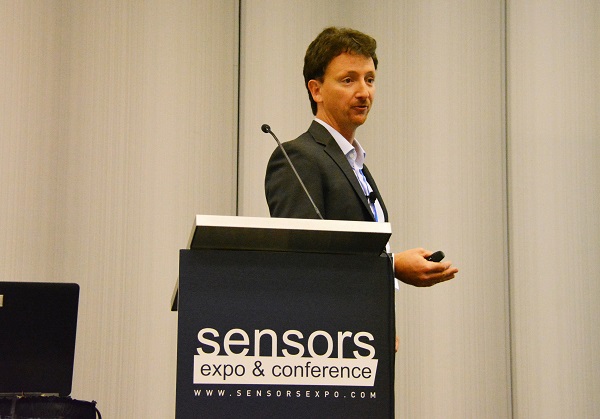
“I really believe we are moving to a 3D type of approach, with the technology,” said STMicroelectronics Product Marketing Manager Edoardo Gallizio.
During his session entitled “Blue Coin: The Robotic Ear”, Edoardo detailed the ways his company’s new robotic kit, with a coin-sized board, enables robots.
“We decided a few months ago to develop Blue Coin,” he said. 
Blue Coin, Eduardo said, had motion sensors, pressure sensors, and Bluetooth included in it.
“(With this), a home robot can follow you, listen to you and speak to you. We can send actual music. And then, we have ten degrees of freedom,” he said.
“The whole idea behind offering this kit, is how can we really help IoT applications.”
Blue Coin, he continued, had four microphones–which allowed robots a 360-degree range.
“You can detect where the voice is coming from; you can enable speech recognition,” he explained.
“I hope that this platform will be useful, that it’s just another brick we bring into the IoT system.”
Edoardo told the audience that the kit wasn’t yet available to the general public. “We are announcing (it) here (at Sensors Expo), and it will be available in the next couple of months.”
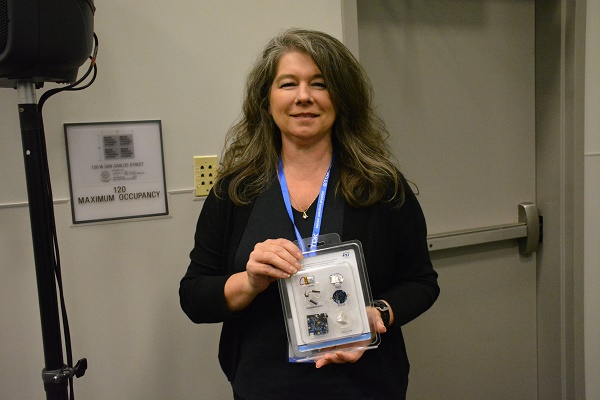
But one attendee can start enabling her robot now–she answered a question correctly and won a Blue Coin kit!
Medically “smart”
“We did a two-year sprint,” said Quvium CEO Steven Schmidt. He and his business partner Karen are the co-creators of the new Sonasure wearable cough monitor.
But when they started creating Sonasure, Steven and Karen didn’t know they were on the IoT. They just knew they were concerned parents. Both Steve and Karen have children with asthma, and they needed a way to monitor for possible asthma attacks.
So Steven and Karen began working with a trained nurse, who manually captured and analyzed sound characteristics of coughs. Their goal: to create a wearable cough monitor.

“Once we found out we were delving into IOT, Lux has this good toolbox for delving into Internet solutions,” Steven told the audience.
And the result of their work and research: their new Sonasure cough monitor, designed to help children and the elderly.
“We had enough medical data to figure out what to do to keep these people healthy,” Steven said. “My cofounder Karen had the dubious honor of watching both her dad with COPD and her child with a respiratory problem. Elderly and children won’t tell you (they’re sick) until they fall over.”
Bouts of coughing, he said, can be a prelude to a medical episode, indicated by cough frequency.
“An asthma cough is two coughs per hour. When (an attack) occurs, it goes up to fifty coughs per hour.”
And each cough–asthma, tuberculosis, or pneumonia–has a distinctive sound pattern.

Due to these unique sound signatures, he said, coughs worked well for a wearable monitor.
“This is what wearables and monitors really like: unique signatures, capturable conditions,” he explained. “In infections, these coughs always last two minutes or less. With disease, they last ten minutes or more.”
Once he and Karen had the data, Steven said, they had to think about design.
“It had to be very robust. It had to be hidden; there’s stigma with a disease. And no moving parts.”
A kind of AI was needed, to create the Sonasure device. “Averages don’t work in health care,” Steven said. “You have to know (it’s your child) and not the kid in the next bed coughing.”
And there was trial and error with their young clients. Children liked to paint the mic holes shut! So the device had to be so small that the kids would forget they were wearing it.
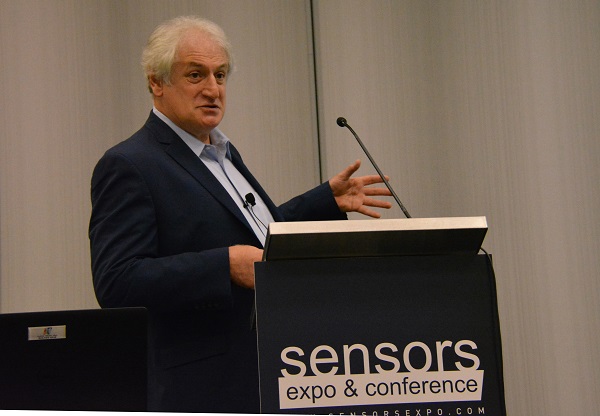
“If it’s out of sight, they’ll leave it alone,” Steven said. And there were other design considerations, based on customer preference.
“We found out in our studies that men want black, and we have two colors for women: purple and white,” Steven said. “Who knew purple is the new black?”
The Sonasure cough monitor will alert family members or a school nurse to a cough frequency that could indicate a health issue. “We have staffers in our call center who speak 25 languages,” Steven said.
The monitor, which can detect one new cough sound out of a million, will be available in its 1.0 version this fall. “The wholly self-contained version will be out, probably, March of next year,” Steven added.
And he offered an interesting fact about medical technology.
“This is the 200th anniversary of the stethoscope. So it’s 200 years of learning on medical sound.
“We feel pretty confident that we can actually change lives with this technology.”
The morning had flown by. And after lunch, an analyst face-off–and a robot–were in the audience’s immediate future.
This is Part 1 of a two-part series.
SENSORS Expo and Conference starts with a networking breakfast at 7:30, Wednesday, June 28th, in San Jose’s McEnery Convention Center, and runs through 2:30 pm Thursday, June 29th. Exhibit halls are open at 10:00.

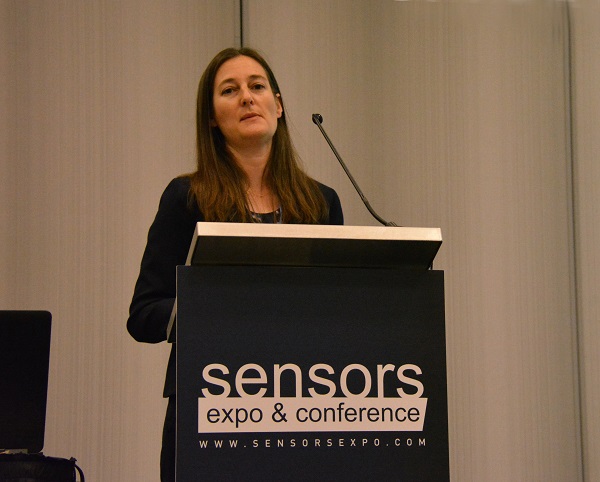
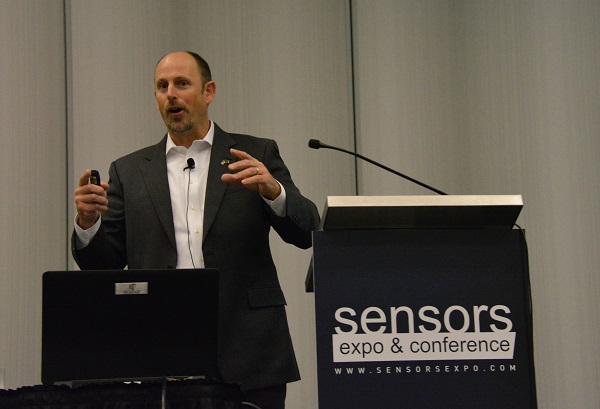
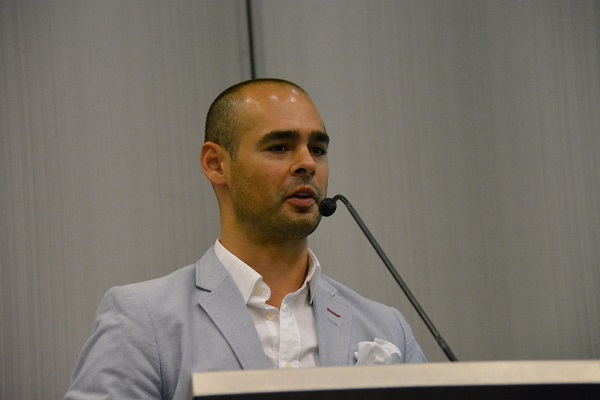
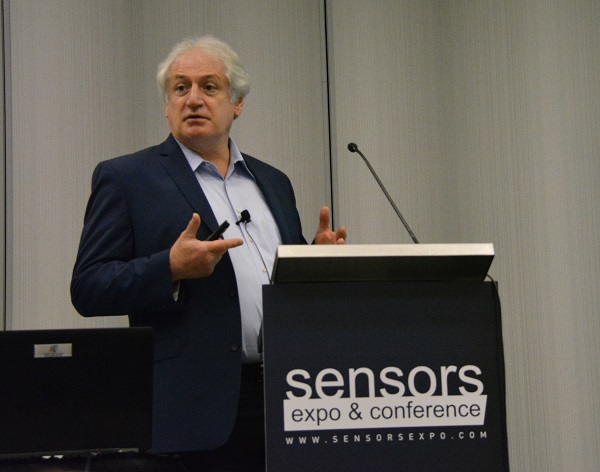
Thanks for the great summary of the IoT pre-con
Thank you for a great, informative event!